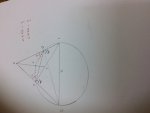saravananr
New member
- Joined
- Nov 13, 2014
- Messages
- 2
While practicing mathematics Olympiad questions , i got the below given question . Though the solution is given , I am not able to bypass certain steps ...
Question: Let \(\displaystyle ABC\) be an acute-angled triangle. The circle \(\displaystyle \Gamma\) with \(\displaystyle BC\) as diameter intersects \(\displaystyle AB\) and \(\displaystyle AC\) again at \(\displaystyle P\) and \(\displaystyle Q,\) respectively. Determine \(\displaystyle \angle BAC\) given that the orthocenter of triangle \(\displaystyle APQ\) lies on \(\displaystyle \Gamma.\)
Solution: Let \(\displaystyle K\) denote the orthocenter of triangle \(\displaystyle APQ.\) Since triangles \(\displaystyle ABC\) and \(\displaystyle AQP\) are similar, it follows that \(\displaystyle K\) lies in the interior of triangle \(\displaystyle APQ.\)
Note that \(\displaystyle \angle KPA\, =\, \angle KQA\, =\, 90^{\circ} \, -\, \angle A.\) Since \(\displaystyle BPKQ\) is a cyclic quadrilateral, it follows that \(\displaystyle \angle BQK \, =\, 180^{\circ}\, -\, \angle BPK \, =\, 90^{\circ}\, -\, \angle A,\) while on the other hand \(\displaystyle \angle BQK \, =\, \angle BQA \, -\, \angle KQA \, =\, \angle A\) since \(\displaystyle BQ\) is perpendicular to \(\displaystyle AC.\) This shows that \(\displaystyle 90^{\circ}\, -\, \angle A\, =\, \angle A,\) so \(\displaystyle \angle A\, =\, 45^{\circ}.\)
Can anyone please explain me why angle KPA and angle KQA are each equal to 90-angle A ? I am not able to get this step .
I have got the following ..

It is evident from the figure that angle KPA = angle CPA - angle XPK = 90 - angle XPA.
So does this mean that angle XPK = angle A ? If yes , plz explain how ?
Awaiting for the get through ...
Question: Let \(\displaystyle ABC\) be an acute-angled triangle. The circle \(\displaystyle \Gamma\) with \(\displaystyle BC\) as diameter intersects \(\displaystyle AB\) and \(\displaystyle AC\) again at \(\displaystyle P\) and \(\displaystyle Q,\) respectively. Determine \(\displaystyle \angle BAC\) given that the orthocenter of triangle \(\displaystyle APQ\) lies on \(\displaystyle \Gamma.\)
Solution: Let \(\displaystyle K\) denote the orthocenter of triangle \(\displaystyle APQ.\) Since triangles \(\displaystyle ABC\) and \(\displaystyle AQP\) are similar, it follows that \(\displaystyle K\) lies in the interior of triangle \(\displaystyle APQ.\)
Note that \(\displaystyle \angle KPA\, =\, \angle KQA\, =\, 90^{\circ} \, -\, \angle A.\) Since \(\displaystyle BPKQ\) is a cyclic quadrilateral, it follows that \(\displaystyle \angle BQK \, =\, 180^{\circ}\, -\, \angle BPK \, =\, 90^{\circ}\, -\, \angle A,\) while on the other hand \(\displaystyle \angle BQK \, =\, \angle BQA \, -\, \angle KQA \, =\, \angle A\) since \(\displaystyle BQ\) is perpendicular to \(\displaystyle AC.\) This shows that \(\displaystyle 90^{\circ}\, -\, \angle A\, =\, \angle A,\) so \(\displaystyle \angle A\, =\, 45^{\circ}.\)
Can anyone please explain me why angle KPA and angle KQA are each equal to 90-angle A ? I am not able to get this step .
I have got the following ..

It is evident from the figure that angle KPA = angle CPA - angle XPK = 90 - angle XPA.
So does this mean that angle XPK = angle A ? If yes , plz explain how ?
Awaiting for the get through ...
Last edited:
